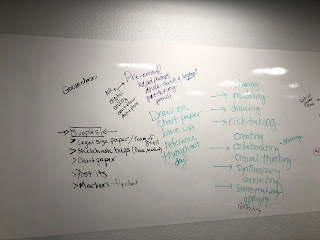 I enjoy January, the start of a new year, and new beginnings. During the past several years, I created resolutions, participated in happiness projects, wrote 18 goals for 2018, and distilled yearly themes to #oneword. (This year's word is heart, by the way.) As part of our work evaluations, we write and submit reflections on our past and future goals, and I really enjoy that process. (I wonder how many people like completing these reflections?) I'm currently working on a portfolio for a certification project, and the synthesis process is very fulfilling for me.
I enjoy January, the start of a new year, and new beginnings. During the past several years, I created resolutions, participated in happiness projects, wrote 18 goals for 2018, and distilled yearly themes to #oneword. (This year's word is heart, by the way.) As part of our work evaluations, we write and submit reflections on our past and future goals, and I really enjoy that process. (I wonder how many people like completing these reflections?) I'm currently working on a portfolio for a certification project, and the synthesis process is very fulfilling for me.In spite of all of my thinking and reflecting, for the past several months, I feel that I lost my sense of direction, and I am zigging and zagging all over the place. I don't think I even realized I was at such a loss until I heard the discussion of "Defining Your Everest" during an interview with Dave Stuart on this podcast. Bottom line, I would like to distill my work into concise, focused goals.
It's not like I've never done something like this before... I discovered this quote in 2006, and it continues to be one of my favorites. It suited me perfectly as a math teacher, Student Council sponsor, instructional specialist, and now as a digital learning consultant.
| A couple years ago, a friend even created this painting for me, and it's prominently hanging in my office. |
I love to help find solutions.The sentence worked in my previous job because it was very "math-y," plus I was working at the campus level to solve problems. Now I find ways technology can solve problems.
I created a 5-word GPS for the 2014-15 school year (my last year on a campus). When I look at the words now, I see my focus was so much about building a community of learners and creating psychological safety in my class...and that is all still good to remember for my professional development sessions.
Last year, I took an online class (#ClassyGraphics) where an optional assignment was to create a manifesto, and I worked for weeks to choose the right words that described my values and beliefs.
Looking at all of these quotes, words, and reflections from past years helps me understand my values and priorities, but how can I be more concise? I see a lot of similarities in my words and ideas. What I like about the Everest Challenge is the teacher says every single day in his classes, his students are working on one or more of his 5-6 broad goals. During the podcast interview, Dave said he started writing his ideas on an index card, carried it around for days (weeks?) to refine and reflect on his words.
What is my work all about? Right now, I'm thinking something like, "I want to help others see how technology empowers us to learn, connect, collaborate, and create." Hmmm... Am I able to spend the majority of my time using technology for learning, connecting, collaborating, and creating? Is this focus fulfilling for me? Suggestions?
Still thinking and reflecting, and always learning.
PS - With "Zigging and Zagging," I'm finally ending my alphabet blogging challenge. Talk about perseverance. It took way too long to finish 26 posts, but I'm glad I did it!






